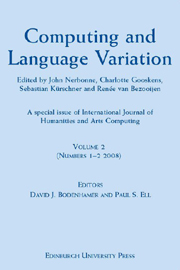Book contents
- Frontmatter
- Contents
- From the Editors
- Notes on Contributors
- 1 Introduction: Language Variation Studies and Computational Humanities
- 2 Panel Discussion on Computing and the Humanities
- 3 Making Sense of Strange Sounds: (Mutual) Intelligibility of Related Language Varieties. A Review
- 4 Phonetic and Lexical Predictors of Intelligibility
- 5 Linguistic Determinants of the Intelligibility of Swedish Words among Danes
- 6 Mutual Intelligibility of Standard and Regional Dutch Language Varieties
- 7 The Dutch-German Border: Relating Linguistic, Geographic and Social Distances
- 8 The Space of Tuscan Dialectal Variation: A Correlation Study
- 9 Recognising Groups among Dialects
- 10 Comparison of Component Models in Analysing the Distribution of Dialectal Features
- 11 Factor Analysis of Vowel Pronunciation in Swedish Dialects
- 12 Representing Tone in Levenshtein Distance
- 13 The Role of Concept Characteristics in Lexical Dialectometry
- 14 What Role does Dialect Knowledge Play in the Perception of Linguistic Distances?
- 15 Quantifying Dialect Similarity by Comparison of the Lexical Distribution of Phonemes
- 16 Corpus-based Dialectometry: Aggregate Morphosyntactic Variability in British English Dialects
7 - The Dutch-German Border: Relating Linguistic, Geographic and Social Distances
Published online by Cambridge University Press: 12 September 2012
- Frontmatter
- Contents
- From the Editors
- Notes on Contributors
- 1 Introduction: Language Variation Studies and Computational Humanities
- 2 Panel Discussion on Computing and the Humanities
- 3 Making Sense of Strange Sounds: (Mutual) Intelligibility of Related Language Varieties. A Review
- 4 Phonetic and Lexical Predictors of Intelligibility
- 5 Linguistic Determinants of the Intelligibility of Swedish Words among Danes
- 6 Mutual Intelligibility of Standard and Regional Dutch Language Varieties
- 7 The Dutch-German Border: Relating Linguistic, Geographic and Social Distances
- 8 The Space of Tuscan Dialectal Variation: A Correlation Study
- 9 Recognising Groups among Dialects
- 10 Comparison of Component Models in Analysing the Distribution of Dialectal Features
- 11 Factor Analysis of Vowel Pronunciation in Swedish Dialects
- 12 Representing Tone in Levenshtein Distance
- 13 The Role of Concept Characteristics in Lexical Dialectometry
- 14 What Role does Dialect Knowledge Play in the Perception of Linguistic Distances?
- 15 Quantifying Dialect Similarity by Comparison of the Lexical Distribution of Phonemes
- 16 Corpus-based Dialectometry: Aggregate Morphosyntactic Variability in British English Dialects
Summary
Abstract In this paper we relate linguistic, geographic and social distances to each other in order to get a better understanding of the impact the Dutch-German state border has had on the linguistic characteristics of a sub-area of the Kleverlandish dialect area. This area used to be a perfect dialect continuum. We test three models for explaining today's pattern of linguistic variation in the area. In each model another variable is used as the determinant of linguistic variation: geographic distance (continuum model), the state border (gap model) and social distance (social model). For the social model we use perceptual data for friends, relatives and shopping locations. Testing the three models reveals that nowadays the dialect variation in the research area is closely related to the existence of the state border and to the social structure of the area. The geographic spatial configuration hardly plays a role anymore.
INTRODUCTION
The Dutch-German state border south of the river Rhine was established in 1830. Before that time, the administrative borders in this region frequently changed. The Kleverlandish dialect area, which extends from Duisburg in Germany to Nijmegen in The Netherlands, crosses the state border south of the Rhine. The area is demarcated by the Uerdingen line in the south, the diphthongisation line of the West Germanic ‘i’ in the West, and the border with the Low Saxon dialects of the Achterhoek area in the North-East. The geographic details of the area can be found in Figure 1 (the state border is depicted with a dashed-dotted line).
Information
- Type
- Chapter
- Information
- Computing and Language VariationInternational Journal of Humanities and Arts Computing Volume 2, pp. 119 - 134Publisher: Edinburgh University PressPrint publication year: 2009
